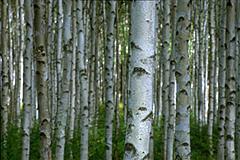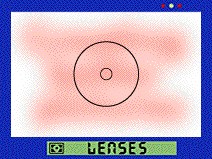To date, we've used this forum to discuss everything from camera basics to
personalizing the look of your AF single-lens reflex camera (SLR) photos. All it takes is
a bit of application of camera technique to take pictures that are truly unique.
In this issue and the next issue, we will take a closer look at lenses and their
respective characteristics.
Different types of lens
To get a better idea of the shooting range capability of a 35mm-105mm lens for 35mm-format
SLR camera lens, a wide-angle panoramic vista would be framed best at the 35mm end of the
focal scale, while a tight, detailed closeup would be best served using a 105mm framing.
One characteristic that makes SLR cameras so versatile is that they can use a wide variety
of interchangeable lenses. The Nikkor lineup offers lenses for every conceivable purpose,
whether it be wide angle, standard, telephoto, zoom, or micro shooting.

Wideangle lens
|

Telephoto lens |

Zoom lens
|
Lens brightness and f-number
In a lens catalog, the number after f/, such as 50mm f/1.4, is called an f-number (maximum
aperture). This value indicates the brightness of the lens expressed as the focal length
of the lens divided by the effective aperture. The smaller the f-number, the brighter the
lens.
A single lens usually has a small f-number, whereas a zoom lens usually has a large
f-number, so the view through the viewfinder appears dark and manual focusing becomes
difficult using a zoom. In an AF camera, however, focusing is automatic, so even if the
f-number is large (i.e. the lens is dark), the camera easily takes a sharply focused
picture.
The advantages of a bright lens
Ample light entering through the lens brightens the viewfinder view to facilitate manual
focusing. Since faster shutter speeds could be used under such conditions, a bright lens
effectively reduces the likelihood of camera shake that blurs images (especially of moving
subjects).
Here's a comparison of respective shutter speeds used for three f-numbers (maximum
aperture), f/5.6, f/4, and f/1.4, when shooting a subject under conditions of identical
brightness:
|
|
| f-number |
Shutter Speed |
| f/5.6 |
1/30 sec. |
| f/4 |
1/60 sec. |
| f/1.4 |
1/500 sec. |
|
Thus, the smaller the lens' f-number (maximum aperture), the faster the
shutter speed that can be used for shooting, given constant subject brightness.
Picture angle
Lens picture angle determines that portion of the subject appearing in the photographic
frame. It follows that the lens mounted on the camera has a direct bearing on the view
seen through the viewfinder. A wide picture angle corresponds to a wide area of view,
while a small picture angle corresponds to a small area of view.
Picture angle manifests itself in 3 film frame dimensions:
(1) Diagonal, (2) Horizontal, and (3) Vertical.
- Diagonal Picture angle
Angle of a film frame's diagonal length from the center (main) point of the lens.
Generally, when we refer to picture angle, we mean diagonal picture angle.
- Horizontal Picture angle
Angle of a film's horizontal range (36mm) from the center (main) point of the lens.
- Vertical Picture angle
Angle of a film's vertical range (24mm) from the center (main) point of the lens.
Lens and Angle of View (area seen in viewfinder)
| Lens Type |
Angle of View |
Picture Area
(area seen in viewfinder) |
| Wide-angle |
Wide |
Wide |
| Standard |
Regular |
Close-to-human view |
| Telephoto |
Narrow |
Narrow |
| Zoom Lens |
Variable |
Variable |
Depth of field
This is the photographic zone of focus.
For example, when focusing on someone facing the camera 1m ahead, the camera also focuses
on everything within a specific zone extending from an imaginary line in front of that
person to one behind the person. This zone circumscribes the camera's depth of field. If
the camera-to-subject zone of focus is wide, depth of field is "deep". If the
camera-to-subject zone of focus is narrow, depth of field is "shallow".
Depth of field depends on aperture, focal length, and shooting distance. Also, the depth
of field is shallow to the line closest to the camera, and deep to the line farthest from
it (the ratio of 1:2).
|
|
| The Depth of Field |
| Depth of field |
shallow |
deep |
| Aperture |
open (smaller value) |
close (larger value) |
| Focal length |
long (telephoto lens) |
short (wide-angle lens) |
| Shooting distance |
near |
far |
|

shallow depth of field
|

deep depth of field
|
|

![]()
